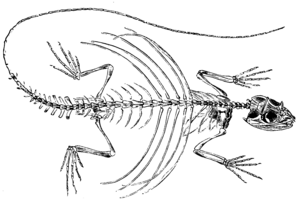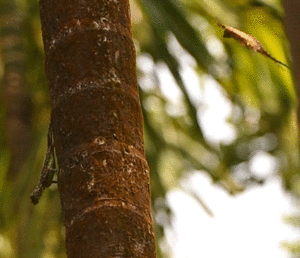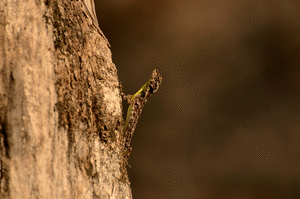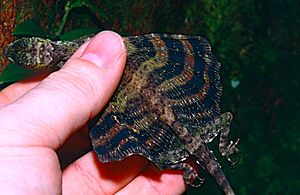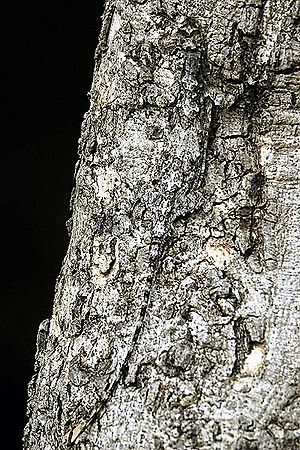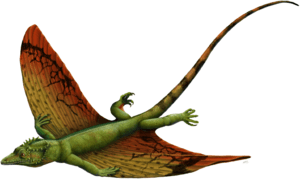Draco (lizard) facts for kids
Quick facts for kids Draco (lizard) |
|
|---|---|
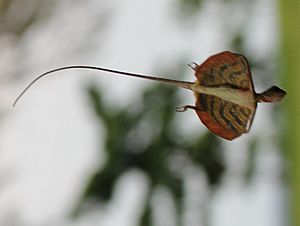 |
|
| D. taeniopterus in mid-glide, on Bulon Island, Thailand | |
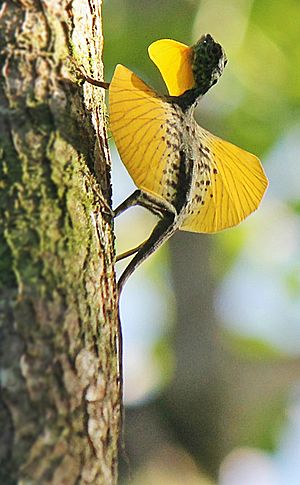 |
|
| Male D. spilonotus extending the dewlap (throat flap) and patagia ("wings") in Sulawesi, Indonesia | |
| Scientific classification |
|
| Kingdom: | Animalia |
| Phylum: | Chordata |
| Class: | Reptilia |
| Order: | Squamata |
| Suborder: | Iguania |
| Family: | Agamidae |
| Subfamily: | Draconinae |
| Genus: | Draco Linnaeus, 1758 |
| Species | |
|
41 species (see text) |
|
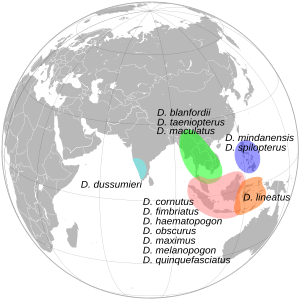 |
|
Draco is a group of amazing lizards often called flying lizards or flying dragons. They can glide through the air using special "wings" that are actually stretchy skin supported by their ribs. These lizards live mostly in trees and eat insects.
Even though they can't flap their wings to fly like birds, they are excellent gliders. Some have been seen gliding as far as 60 m (200 ft) (about 200 feet)! That's a long way for a lizard that's only about 20 cm (7.9 in) (8 inches) long, including its tail. You can find these lizards in forests, gardens, and plantations across Southeast Asia and southern India.
Contents
Discovering the Flying Dragon
The scientist Carl Linnaeus first described the Draco group in 1758. He named them after the mythological dragons because of their unique ability to glide. For a while, some people thought their "wings" were just for show, but research in the late 1950s proved that they really do use them for gliding.
How Flying Lizards Glide
Draco lizards are famous for their "wings," which are actually membranes of skin called patagia. These membranes are supported by long ribs. They help the lizards create lift to glide. Their back legs also help make their body shape smooth for gliding.
Gliding helps them escape from animals that want to eat them. It's also their main way of moving around in their forest home. When they want to glide, they jump and point their head down. They then flatten their body so it's parallel to the ground. As they glide, their back arches, making their wings curved like an airplane wing. Their front legs hold the front edge of the wings to help steer. They can glide at speeds between 5.2 and 7.6 meters per second (about 17 to 25 feet per second).
When it's time to land, they release their wings just before touching down. They land feet-first, using their front feet first, then their back feet.
Where They Live and What They Eat
Draco lizards mostly live in tropical rainforests. They almost never go down to the forest floor. They are insectivores, meaning they eat insects. Their favorite foods are ants and termites.
They usually stay still on tree trunks or branches, waiting for their prey to come close. Once an insect is within reach, they quickly snap it up. The color of their wings often matches the color of the local falling leaves. This helps them hide from birds that might try to catch them.
Social Life and Babies
Draco lizards are very territorial. This means they have their own special area, usually one or a few trees, that they protect. Male lizards actively guard their territory. If a male leaves, another male will quickly take over the empty space. Female lizards can move freely through different territories.
Males use their colorful wings and a flap of skin under their throat, called a dewlap, to show off. They do this to attract females or to warn other males to stay away. The dewlap is see-through and they point it towards the sun to make it more visible.
Female Draco lizards are bigger than males. The only time a female goes to the ground is to lay her eggs. She digs a hole in the soil with her head. Then she lays 2 to 5 eggs. She covers the hole and guards the eggs for about 24 hours. After that, she leaves and doesn't take care of her babies anymore.
Where to Find Them
You can find different types of Draco lizards in the forests all over Southeast Asia. One species, called Draco dussumieri, lives in Southern India.
Types of Flying Lizards
There are 41 known species of Draco lizards, including:
- Draco abbreviatus – Singapore flying dragon
- Draco blanfordii – Blanford's flying dragon
- Draco dussumieri – Indian flying lizard
- Draco fimbriatus – fringed flying dragon
- Draco lineatus – lined flying dragon
- Draco maximus – great flying dragon
- Draco quinquefasciatus – five-lined flying dragon
- Draco sumatranus – common gliding lizard
- Draco volans – common flying dragon
Ancient Gliding Reptiles
It's cool to know that Draco lizards aren't the only reptiles that have learned to glide! Many other types of reptiles from long ago also developed similar ways to glide. This is called convergent evolution, where different animals develop similar traits independently.
The oldest known gliding reptiles were the weigeltisaurids. They lived about 258 to 252 million years ago! Other ancient gliding reptiles include the Triassic kuehneosaurids and Mecistotrachelos, and the Cretaceous lizard Xianglong.
See also
 In Spanish: Draco (género) para niños
In Spanish: Draco (género) para niños
- Flying and gliding animals
- Chrysopelea gliding snake


